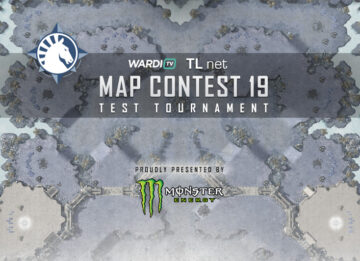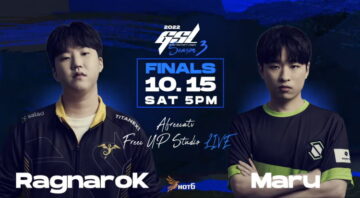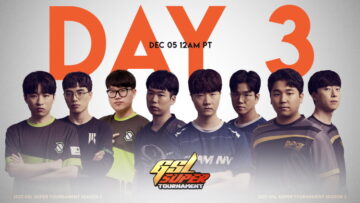By: Mizenhauer
It’s rare indeed that you see innovation in a grand finals (not to be confused with INnoVation). No matter the sport, electronic or otherwise, finals have a tendency to be defined by the lack of risks taken by the participants. Leaning into the tried and true is the preferred way to go, and the same is true with StarCraft II.
Yes, you’re likely to see a variety of builds, but within the ‘normal’ bounds of risk-taking in long series. After all, it’s not as if a player can employ the same build seven times in a row and expect their opponent to play along. But rarely do players abandon the fundamental gameplay that got them to the finals in the first place.
The series we’re here to examine is one of the rare exceptions.
Let’s go all the way back to 2016, to the first full year of Legacy of the Void. By then, Dark and Stats were already on their way to becoming greats of the game. Stats had been a Proleague stalwart for KT Rolster, while had logged a pair of second place finishes in KeSPA Cups 1 and 2 in 2015. While it’s hard to pinpoint the exact time at which the two players graduated into legitimate top-tier players, one could argue it was when they met in the finals of SSL Season 1 in 2016.
Dark arrived in the finals from the winners’ side of the double elimination bracket, having gone on a ZvP rampage which victimized MyuNgSiK, Classic, and even Stats himself (with a whopping 8-0 combined map score in those matches). Phoenix play and Adept timings were extremely popular at the time, and Dark had progressed through the event by countering them with Queen drops and Roach-centric armies. It being Dark, some aggressive builds had obviously mixed in, but Dark hadn’t really been doing anything noticeably unusual given the meta ZvP at the time. Specifically, against Stats, he had previously won two games with early Roach all-ins and a third with Hydra-Roach-Ravager in the mid-game.
Meanwhile, Stats had redeemed himself somewhat with a 4-3 win over Solar in the losers’ final. It had been a very standard series for the time, where he opened Phoenix into double-Robo Immortals in six of the seven games. These circumstances are what make Dark’s performance in the biggest match of his career, up to that point, so fascinating.
[embedded content]
The series kicked off in fairly unremarkable fashion on Prion Terraces, with Stats opting for a Stargate and Dark teching up for some light Baneling drop harass. Various forms of early drop harass were already commonplace in the fledgling expansion (several Overlord changes in LotV enabled this kind of play), and Dark had already employed versions of these strategies in approximately half of the eight ZvP maps he had previously played that season (including against Stats).
Mining off of two gold-mineral bases (Prion Terraces’ had gold bases at both the natural and third), Dark cut Drones to hit a timing of mass Zerglings supported by Banelings and Queens. The attack was a huge success, taking out Stats’ third base and denting his Probe count severely. Stats did his best to stage a comeback, scraping together a mostly Stalker army and moving out.
However, this is where he ran into Dark’s big surprise: mass Zerglings. Up to that point in the LotV meta, no one had leaned so hard into Zerglings as the core of their force in a macro game—Roach/Ravager and Hydralisks were the units of choice at the time. With barely any splash damage in his army, Stats’ army was completely overrun and he had no choice but to give the GG.
![[image loading]](https://platogaming.com/wp-content/uploads/2023/12/all-time-audacity-dark-in-ssl-season-1-2016.jpg)
It would be much more satisfying if they exploded into blue goo.
Now, this might seem like a rather lame innovation at first. A player gets ahead with Zerglings on a gold mineral map, and then finishes the game with Zerglings—what’s the big deal? But if anyone had thought mass Ling-Bane was just a strategy tailored to Prion Terraces, Dark made it clear that this was a paradigm shift in game two.
Playing on the Dusk Towers, the two players progressed into another standard early game with Stats opening Phoenixes while Dark prodded around with drops. This time, Dark didn’t have any early/mid-game timing in store, but went up to 80+ Drones and held down on the “Z” and “E” keys once more.
This time, Dark’s mass Ling-Bane was just supposed to keep Stats at bay until Brood Lord tech was ready. However, the composition was so effective it actually ended up winning him the game directly. Stats had assembled a task force of Zealot-Immortal-Archon-Phoenix to strike before Brood Lords, which might have performed decently with a high Archon ratio. However, Stats didn’t anticipate or respect the power of mass Ling-Bane at all, and had just three Archons against 70+ cracklings and a slew of supporting Banelings. Dark’s Ling-Bane utterly annihilated Stats’ army, leaving his Brood Lords an extremely easy clean-up job.
![[image loading]](https://platogaming.com/wp-content/uploads/2023/12/all-time-audacity-dark-in-ssl-season-1-2016-1.jpg)
It’s hard to tell due to the 2016 video quality, but there’s 2348390 Zerglings destroying Immortals in this picture.
Game three was a change of pace for Dark, who decided to go for a Roach-Ravager all-in on Ulrena. However, Stats’ future reputation as the Shield of Aiur came through here, and he defended the all-in to grab a foothold in the series.
After that ill-fated outing, Dark returned to playing his new standard composition of Ling-Bane in game four, while Stats showed us what he had learned from his initial two losses. Rather than try and radically change his unit mix to better counter Ling-Bane, Stats decided instead to largely forgo early/mid-game pressure and aim for the late-game. It’s likely that this was partially due to the map being the macro-friendly Orbital Shipyard, but Stats did seem to be more aware of the threat of being enveloped on open ground.
This strategic shift was successful for Stats in the sense that he didn’t straight-up die to Ling-Bane in the mid-game, but it brought him no closer to victory. After all, Dark’s Ling-Bane in game two was meant to hold him over until he could assemble a Hive army, which he was just as good at wielding. Not only that, but Dark was able to get in some decent Ling-Bane harass despite Stats’ more passive posture, giving him an advantage headed into the late-game.
The deciding battle between Dark’s Brood Lord-Corruptor-Ultralisk-Infestor swarm versus Stats’ Tempest-Void Ray-Templar armada was rather similar to contemporary late-game ZvP fights—specifically, the kind that Serral wins after a huge Corruptor remax.
![[image loading]](https://platogaming.com/wp-content/uploads/2023/12/all-time-audacity-dark-in-ssl-season-1-2016-2.jpg)
Doesn’t look bad for Protoss…
…until you consider the banks
Having gone 1-1 with aggressive openers in the series, Dark went back to the cheese cellar once more for game five on Central Protocol. Hydralisks figured into his strategy for the first time, as he attempted to hit a Hydra-Ling-Bane timing at around the 8:30 mark.
However, just as in game two, Stats proved to be rock solid on defense. Banelings ran up against a wall of beautifully placed Force Fields, and most of them were picked off without delivering their acidic payload.
![[image loading]](https://platogaming.com/wp-content/uploads/2023/12/all-time-audacity-dark-in-ssl-season-1-2016-3.jpg)
A classic Shield of Aiur moment.
While Dark hadn’t been completely all-in, the failed attack left him at a serious disadvantage. Amusingly enough, he decided to belatedly pivot to his Ling-Bane into Brood Lords strategy, which kept him in the game for quite a while longer (albeit, Stats was totally content to slowplay his lead). Dark did eventually manage to produce an impressive army stocked with Ultralisks, Corruptors and Brood lords, but without a massive bank with which to rebuild his army, he was unable to recover from a pair of game ending fights.
At this point, the story of Dark’s Ling-Bane play ends, as Stats took the initiative with a strategy change in game six. For the first time in the series, he veered from his direct Stargate openers for the first time in the series, instead going for 3-Gate Adepts into 2-Stargate Phoenixes. This was partially due to the layout of Lerilak Crest, with its wide open natural and easily defensible third base favoring such strategies.
The stratagem seemed to work at first. Stats’ Adepts forced Dark to play defensively early on, and his Phoenixes still came out in time to stop the expected Baneling drop harass. Stats kept cranking out the Phoenixes, which he used to pick off a number of Queens and Drones to establish firm control over the game.
Placed in a tricky situation, Dark pulled an ace out of his sleeve: a Nydus-Roach all-in. With Phoenixes flying all over his territory, it’s hard to tell whether Dark was planning this with genius-level anticipation or it was just a complete roll of the dice. Intentional or not, it worked out so that Stats’ Phoenixes skirmished with Queens some distance away from the Nydus entrance, and kept fighting until it was complete. When the Nydus erupted into the Protoss main, it caught Stats’ completely flat-footed. Unfortunately for Stats, he had expended most of his Phoenix energy on harassment on the other side of the map, and Dark was able to make the attack work through sheer force of numbers. Phoenixes outnumbered Queens 12 to 4, but that problem was solved with Spores built in the Protoss main. With his Phoenixes watching helplessly overhead, Stats gave the final GG that confirmed the first major championship of Dark’s career.
![[image loading]](https://platogaming.com/wp-content/uploads/2023/12/all-time-audacity-dark-in-ssl-season-1-2016-4.jpg)
At least Corruptors could have tried a funny basetrade.
*****
In retrospect, it’s no shock that Dark won the series. He ended being the best Zerg of 2016, adding an SSL silver medal in Season 2 and a runner-up finish at BlizzCon. Solar was the only other Zerg to even reach a premier-tier tournament final that year (beating Dark in the aforementioned SSL Season 2). And, while Dark would go on to win two Code S champions and a BlizzCon title in later years, I still find his first ever title to be his most impressive due to his sheer bravado.
Across the 13 year history of StarCraft II, I don’t know if anyone has ever used the defining feature of the GSL and SSL—the enormous length of time players have to prepare ahead of matches—so daringly. It’s one thing to bring a series of one-off cheeses—it’s another thing entirely to introduce a whole new foundation for your game. By providing Stats with misinformation for essentially and entire season, Dark was able to refine and employ a playstyle that caught the usually unshakable Protoss off guard. Stats did a fantastic job defending against established tactics, taking minimal damage from the conventional drop harass and two of the three timing attacks Dark threw his way. But when Dark broke out the upgraded Line-Bane style, Stats just wasn’t ready.
Now, it would be vastly oversimplifying the series to say Ling-Bane use was THE reason Dark won the finals—he did so many other things right. And, if you wanted to nitpick the Ling-Bane victories in the series, you could point out that the first was already in the bag due to Dark’s early game timing, the second was aided by Stats walking into a perfect surround, and the third was really a late-game win after Dark had discarded all of his Ling-Bane.
But even when you take those factors into consideration, it doesn’t diminish the fact that Dark was willing to completely change up his base playstyle in the grand finals to give himself a better chance of winning. Whether that contributed 10% or 90% to the victory, it was a supremely bold decision that could only have come from the mind of one of StarCraft II’s most audacious players.
- SEO Powered Content & PR Distribution. Get Amplified Today.
- PlatoData.Network Vertical Generative Ai. Empower Yourself. Access Here.
- PlatoAiStream. Web3 Intelligence. Knowledge Amplified. Access Here.
- PlatoESG. Carbon, CleanTech, Energy, Environment, Solar, Waste Management. Access Here.
- PlatoHealth. Biotech and Clinical Trials Intelligence. Access Here.
- Source: https://tl.net/forum/starcraft-2/618883-all-time-audacity-dark-in-ssl-season-1-2016
- 1
- 12
- 13
- 2015
- 2016
- 30
- 500
- 8
- a
- able
- actually
- adding
- adept
- ADvantage
- aforementioned
- after
- Against
- aggressive
- ahead
- aim
- All
- along
- already
- an
- and
- Another
- anticipate
- anticipation
- any
- anyone
- Anything
- approximately
- ARE
- argue
- Army
- around
- arrived
- as
- assembled
- At
- attack
- attacks
- audacious
- aware
- away
- back
- bad
- Bank
- base
- Battle
- Bay
- BE
- beautifully
- becoming
- been
- before
- being
- BEST
- Better
- better chance
- between
- BIG
- Biggest
- Blue
- bold
- both
- bounds
- bring
- brought
- build
- builds
- built
- but
- by
- came
- CAN
- Career
- caught
- central
- Champions
- Championship
- chance
- change
- changes
- choice
- circumstances
- Classic
- clear
- closer
- code
- combined
- come
- complete
- completely
- composition
- confirmed
- Consider
- consideration
- contemporary
- content
- contributed
- Control
- conventional
- Core
- could
- counter
- countering
- Cut
- damage
- Dark
- deal
- decided
- decision
- Defense
- defined
- defining
- delivering
- despite
- DICE
- DID
- didn
- die
- direct
- directly
- distance
- do
- doesn
- doing
- don
- double
- down
- Drones
- Drop
- drops
- due
- e
- Early
- easily
- easy
- Effective
- electronic
- embedded
- employed
- enabled
- ended
- ending
- ends
- energy
- enormous
- enough
- entire
- entirely
- Entrance
- Essentially
- establish
- established
- even
- Event
- eventually
- EVER
- examine
- expansion
- expect
- expected
- extremely
- fact
- Factors
- Failed
- fascinating
- Fashion
- Feature
- Fields
- Fighting
- fights
- figured
- Final
- find
- finish
- Firm
- First
- first place
- first time
- flying
- For
- force
- forced
- forms
- Foundation
- from
- full
- fundamental
- funny
- future
- game
- gameplay
- Games
- gave
- Get
- gets
- GG
- give
- given
- Giving
- go
- going
- Gold
- gone
- good
- got
- grab
- grand
- grand finals
- Ground
- guard
- had
- half
- harassment
- Hard
- has
- Have
- having
- he
- headed
- held
- here
- High
- him
- himself
- his
- history
- HIT
- Hive
- hold
- however
- HTTPS
- huge
- i
- if
- ii
- image
- Immortals
- impressive
- in
- Including
- indeed
- info
- initial
- Initiative
- Innovation
- instead
- into
- introduce
- Is
- IT
- ITS
- Job
- jpg
- just
- keep
- kept
- keys
- kind
- know
- KT Rolster
- lack
- largely
- later
- layout
- lead
- learned
- least
- leaving
- left
- legacy
- legitimate
- light
- like
- likely
- loading
- logged
- Long
- longer
- Look
- Lords
- losses
- Macro
- made
- main
- major
- make
- manage
- many
- map
- Maps
- mark
- mass
- massive
- Match
- matches
- matter
- meant
- met
- Meta
- might
- mind
- mineral
- Misinformation
- mix
- mixed
- moment
- more
- most
- mostly
- moving
- much
- Natural
- New
- no
- normal
- not
- number
- numbers
- Obviously
- of
- off
- on
- once
- One
- only
- open
- opened
- opening
- or
- orbital
- Other
- otherwise
- out
- over
- Overlord
- pace
- pair
- paradigm
- participants
- Passive
- perfect
- performance
- performed
- phoenix
- pick
- Picked
- picture
- Pivot
- place
- planning
- plato
- plato data intelligence
- platodata
- platogaming
- play
- played
- player
- players
- Playing
- Point
- Popular
- power
- prepare
- pressure
- previously
- probe
- Problem
- Produce
- Protocol
- proved
- providing
- quality
- queens
- quite
- Radically
- Rare
- rarely
- rather
- ratio
- RE
- reach
- Ready
- really
- reason
- Recover
- refine
- Reputation
- respect
- right
- risks
- Rock
- Roll
- s
- same
- satisfying
- say
- score
- scraping
- season
- Season 1
- season 2
- second
- see
- seem
- seemed
- sense
- Series
- serious
- seven
- several
- severely
- shield
- shift
- showed
- side
- Silver
- similar
- situation
- SIX
- So
- solar
- solid
- some
- somewhat
- specifically
- Splash Damage
- Sport
- Stage
- STALKER
- standard
- Starcraft
- Starcraft II
- stats
- still
- stop
- store
- Story
- Strategic
- Strategies
- Strategy
- strike
- style
- success
- successful
- such
- Supported
- supporting
- surprise
- tactics
- tailored
- Take
- taken
- taking
- task
- task force
- tech
- tell
- territory
- than
- that
- The
- the dice
- The Game
- The Initiative
- their
- Them
- then
- there
- These
- they
- thing
- things
- third
- this
- those
- thought
- threat
- three
- Through
- time
- times
- timing
- timings
- Title
- to
- together
- took
- totally
- tournament
- tried
- true
- try
- two
- unable
- unfortunately
- unit
- until
- unusual
- up
- upgraded
- us
- use
- used
- usually
- variety
- various
- versions
- Versus
- very
- victories
- victory
- Video
- walking
- Wall
- wanted
- was
- wasn
- watching
- way
- we
- went
- were
- What
- when
- where
- whether
- while
- WHO
- whole
- wide
- willing
- win
- winners
- winning
- Wins
- with
- within
- without
- won
- Work
- worked
- would
- year
- years
- you
- your
- youtube
- Z
- zephyrnet








![[ASL17] Ro4 Preview: Take Off!](https://platogaming.com/wp-content/uploads/2024/04/asl17-ro4-preview-take-off.png)

![[BSL18] ProLeague - Ro24 Group Stage](https://platogaming.com/wp-content/uploads/2024/03/bsl18-proleague-ro24-group-stage-360x203.png)